Crowns

Duration: 45 minutes
Level: K-8th ESL
Objectives: To boost students’ self esteem by materially celebrating their unique skills and self-expression
Vocabulary: “I am the King/Queen of ______.”
Materials: White paper, scissors, staples, pencils, coloring materials
Procedures:
- Cut an 8”x11” piece of paper into two 4”x11” pieces.
- Cut one of the long sides so that it has small squares going up and down, like the top of a crown.
- Staple both short ends of the pieces of paper together so that it makes a crown
- Consider a talent, skill, or interest that you have, and write that on the crown within the phrase: “King/Queen of _______.”
- Decorate your crown to your heart’s content
- Wear it with pride.
Shield / Family Crest

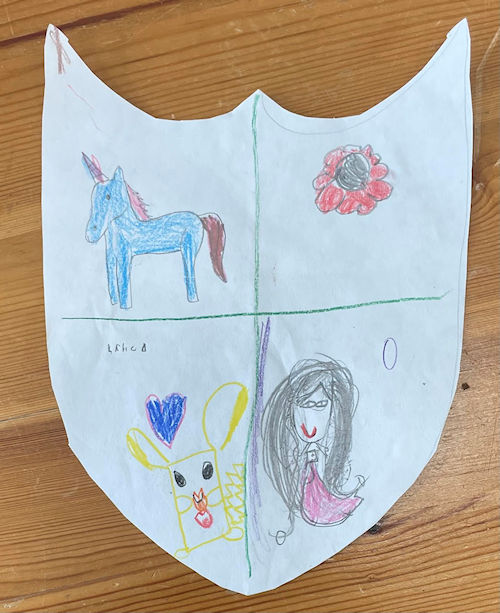
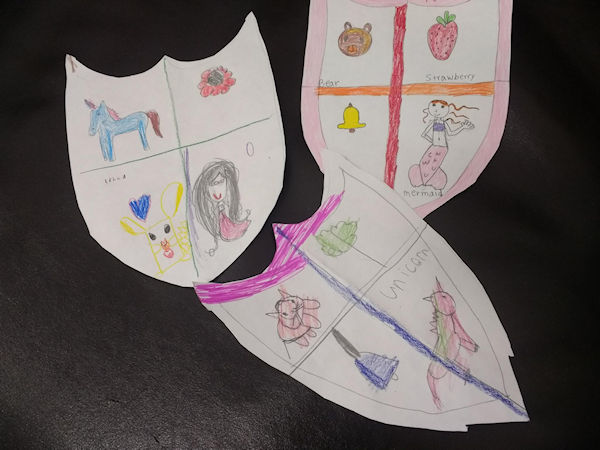
Duration: 30-45 minutes
Level: K-8th ESL
Objectives:To learn how to use iconography to express yourself
Vocabulary: “Crests,” “symbols”
Materials: 8”x11” white paper, pencils, scissors, coloring materials
Procedures:
- Teachers prepare a reference list of the traditional symbols on crests (see example).
- Cut out the shape of a shield from the white paper
- Draw perpendicular lines to make 4 quadrants on the cutout
- Teachers explain how crests are traditionally used to tell other people about yourself through pictures of animals, plants, special objects, and magical animals.
- Teachers display/handout reference lists of the symbols
- In one quadrant, choose an animal to draw
- In one quadrant, choose a plant to draw
- In one quadrant, choose a special object to draw
- In one quadrant, choose a magical animal to draw
- Color and decorate.
Treasure Chests
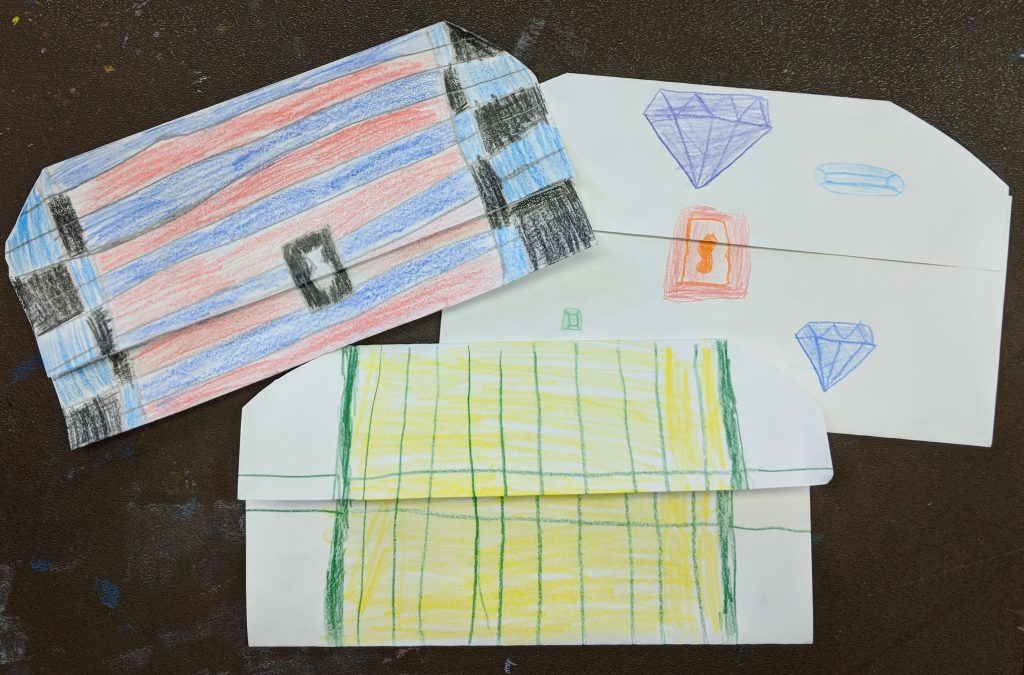

Duration: 30 minutes
Level: K-8th ESL
Objectives: To consider what is most valuable to ourselves
Vocabulary: “Treasure,” “valuable,” “precious”
Materials: Treasure chest template, scissors, pencils, coloring materials
Procedures:
- Fold the template like an envelope so that the lock top and bottom line up
- Cut along the curved lines
- Teachers ask students to consider things, ideas, or people that are personally valuable
- Students draw what is precious to them inside the treasure chest
Castles
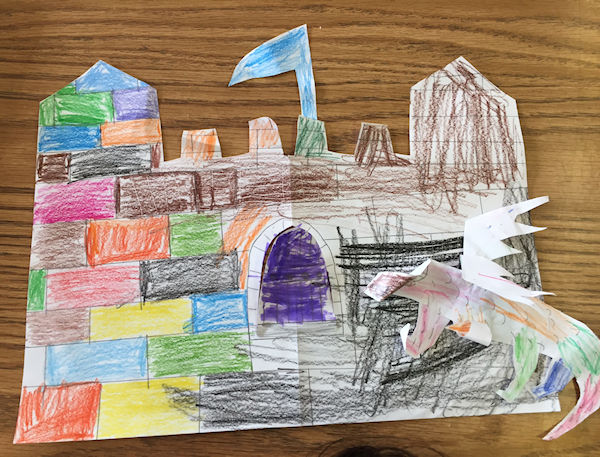
Duration: 30 minutes
Level: K-8th ESL
Vocabulary: “Castle,” “drawbridge,”
Materials: 8”x11” white paper, pencils, scissors, coloring materials
Procedures:
- Fold the white paper in half
- Cut out a tower, wall, and drawbridge (see example)
- Unfold the paper and push down the drawbridge
- Draw and color the castle to your heart’s content. We suggested that our students could decorate the castle to look like their homes or like the example.
Dragons
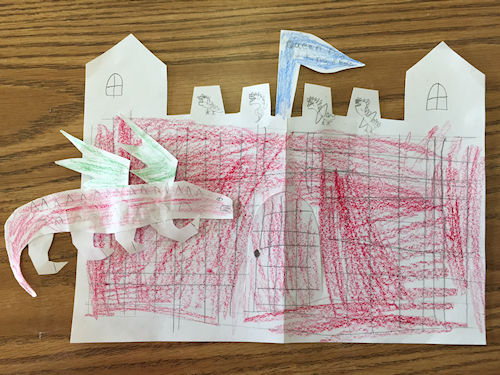
Duration: 1-1.5 hours
Level: K-8th ESL
Objectives: To understand the commonalities and differences among dragons represented in different cultures.
Materials: paper, scissors, tape, pencils, coloring materials
Procedures:
- Cut out of any type of paper: 1 serpentine body, 4 reptilian legs, and 2 wings. When preparing for a class, prepare this amount for each student.
- Explain how to depending on the culture/area of the world from which Dragons appear in mythology, they can look different.
- Demonstrate with example cutouts how they can be just a body, have 2 legs, 4 legs, or 4 legs and wings.
To make a Central American Dragon:
- Hand out just the cut-out of the serpentine body
- Explain how typically Central American dragons look like feathered serpents
- Display an example image of a Central American dragon, such as Quetzcoatl
- Decorate the body cutout with feathers, color them with many different colors
To make a West African Dragon:
- Hand out the serpentine body and 2 reptilian legs
- Explain how typically West African dragons look like large snakes with 2 legs
- Display an example image of a West African dragon, such as Ayida-Weddo
- Tape the leg cutouts to the body
- Decorate and color the body to look like a snake
To make an East Asian Dragon:
- Hand out the serpentine body and 4 reptilian legs
- Explain how typically East Asian Dragons have long bodies and 4 legs
- Display an example image of an East Asian dragon for reference
- Tape the legs to the body
- Decorate the face to include lion-like snout and mustache. Decorate the rest of body as well.
To make a European Dragon:
- Hand out the serpentine body, 4 reptilian legs, and 2 wings
- Explain how typically European Dragons have 4 legs and wings
- Display an example image of a European Dragon for reference
- Tape the legs and wings to the body
- Decorate and color
Reflections
We choose to focus on the theme of fantasy because it offers many opportunities for imagination and creativity. We were able to expand upon the traditional building blocks of a western royalty/fantasy story in many ways and offered opportunities for our students to do the same. With our first project, we introduced self-identification through crown decoration.
Our students really loved this project, and actually spent more time on it than we originally anticipated. They really became enthusiastic about decorating their crowns and finding and sharing their unique self-expression. At the end of class, we encouraged them to share their crowns and tell the class what they were the King or Queen of, and again we saw success in the improvement in the confidence and public speaking skills from many students. In the same vain they also deeply invested themselves in the crest project, which we explained to them was another way to share with others information about yourself through symbols.
The project that captivated them the most however, was the dragons. We designed this project so that they could participate in the assembly and decoration of their dragon, and could customize the number of appendages their dragon had according to our examples. With each of these projects was a learning opportunity as well, which we took to teach them about the theme we were reviewing. The dragon project was also the most successful in this regard, because the educational material was incorporated into the procedures of the project.


